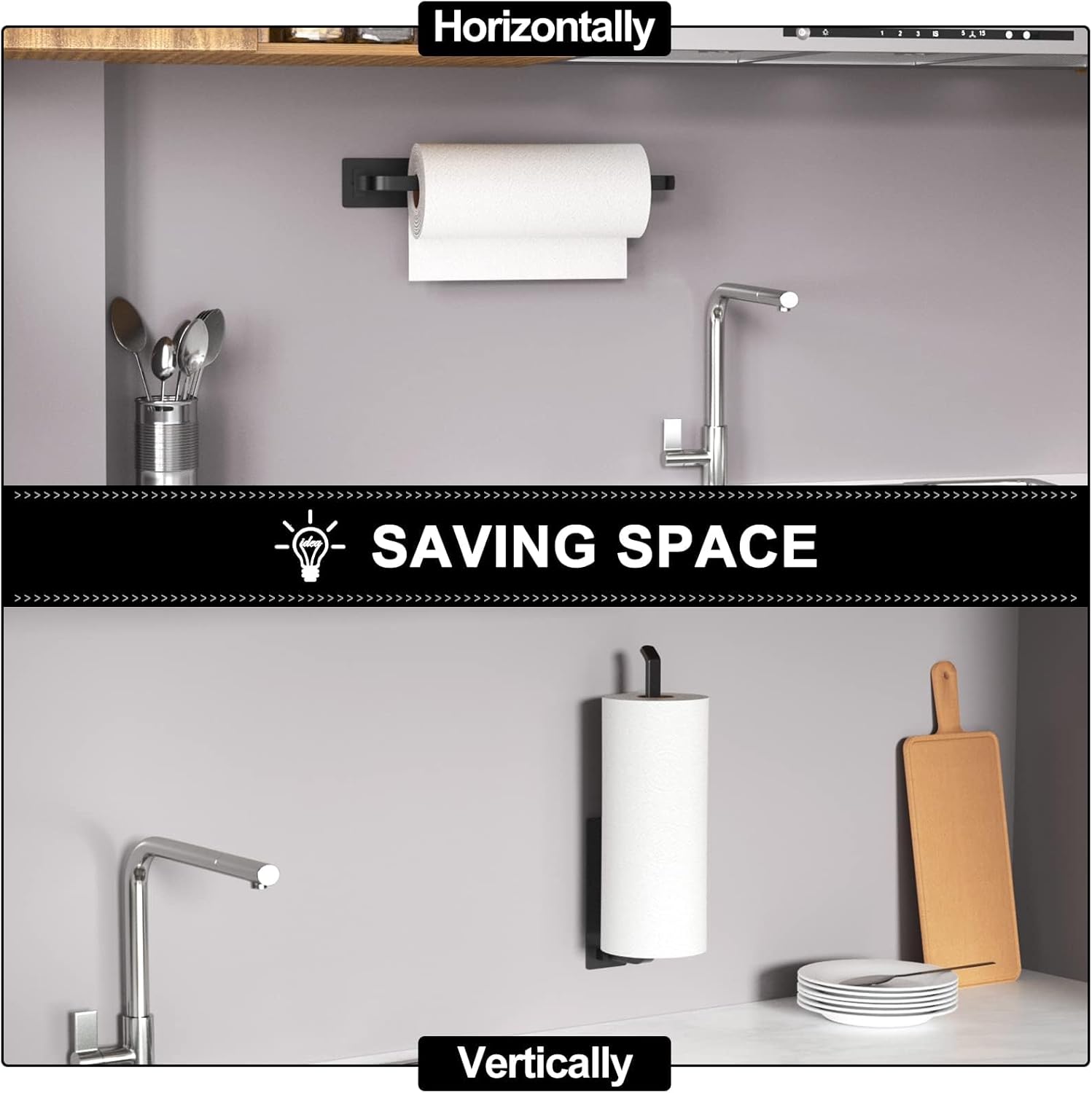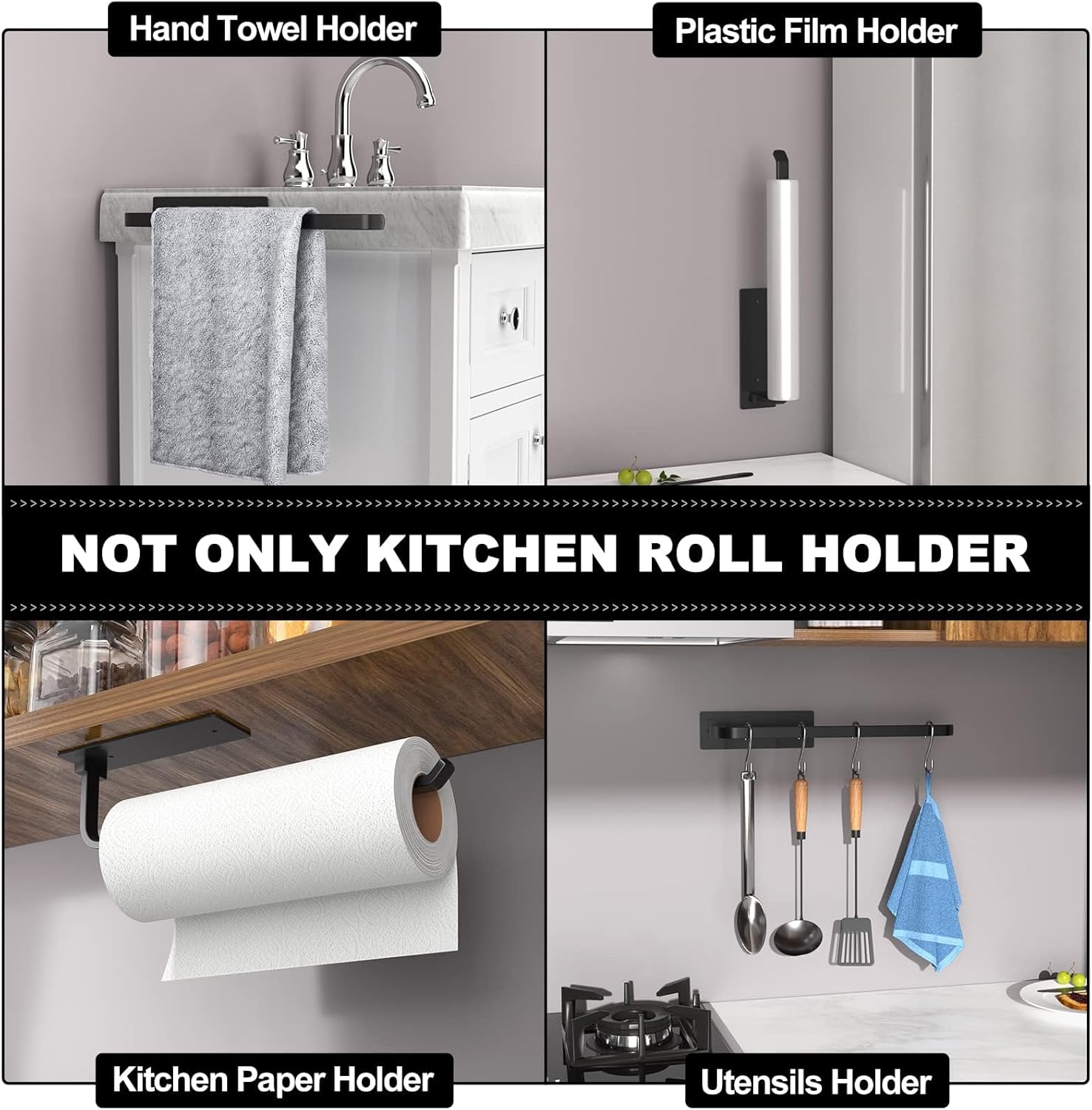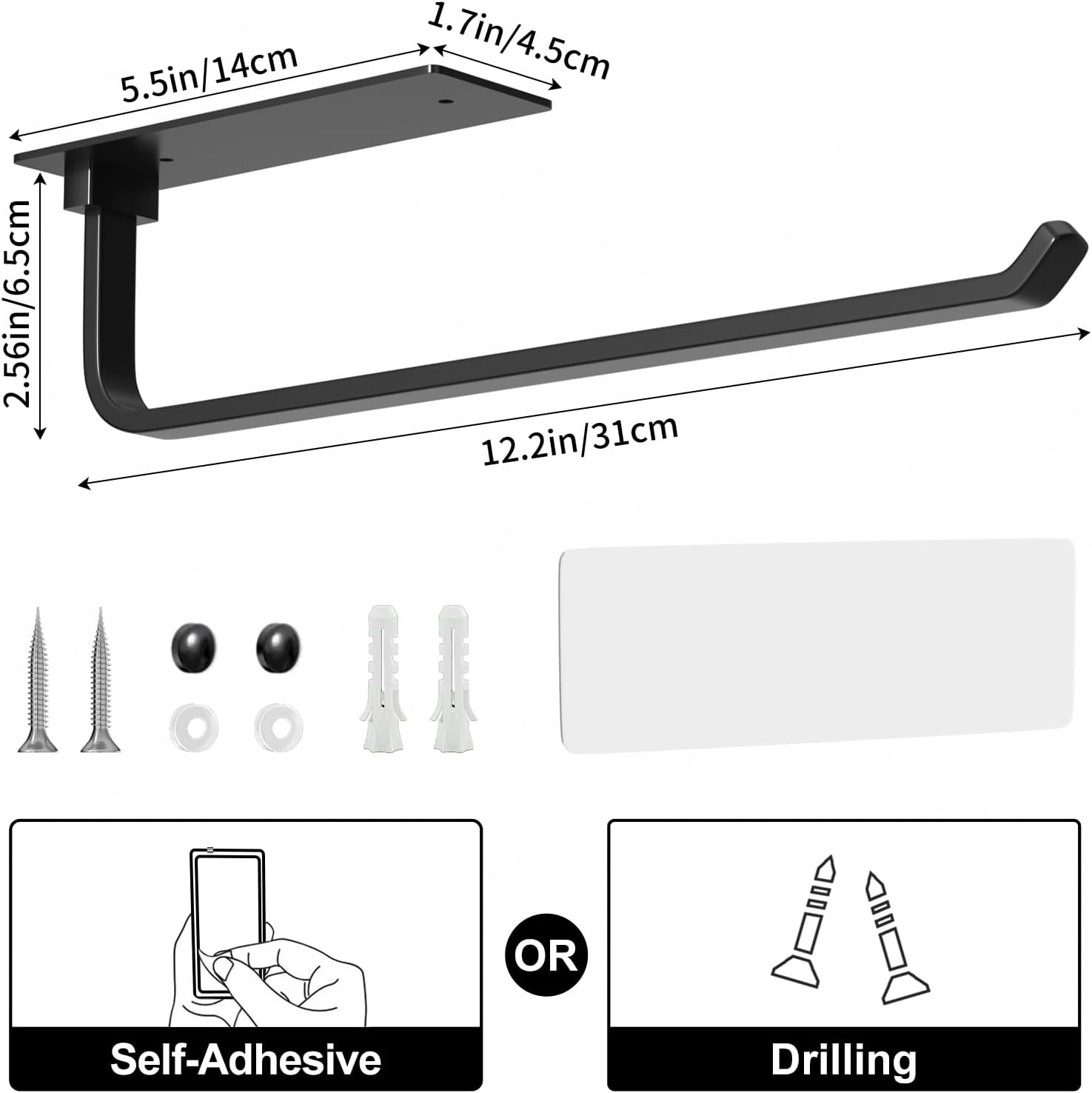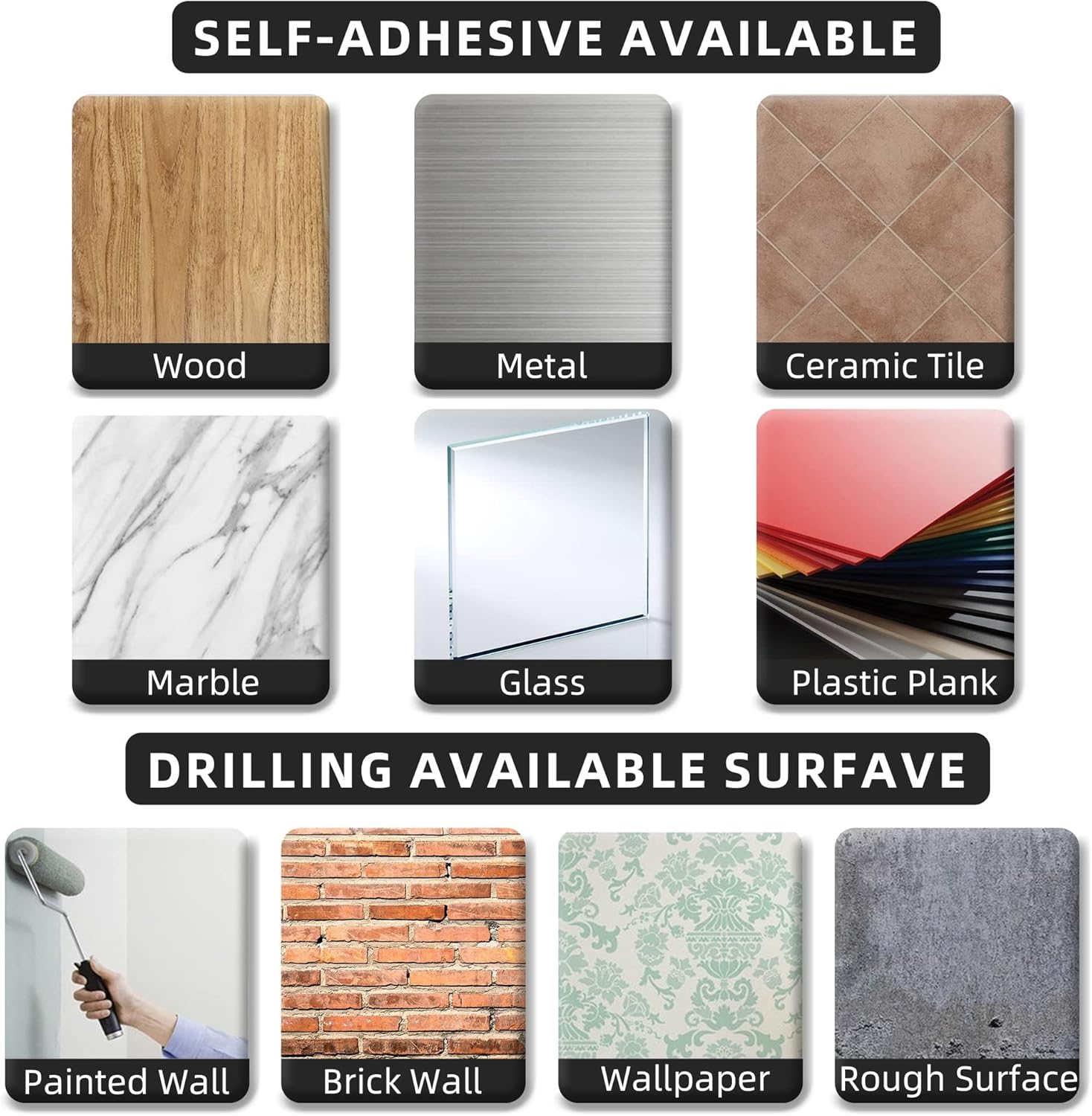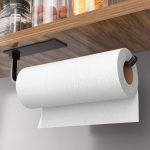
Best Paper Towel Holder – Self-Adhesive or Review paper towel dispenser – Oemiu
The Sticky Situation: Choosing the Right Paper Towel Holder
In the whirlwind of a modern kitchen, even the simplest tools can make a monumental difference in efficiency and organization. One such unassuming hero is the paper towel holder. But the world of paper towel dispensers is more diverse than you might think. Gone are the days of simply plopping a roll on the countertop. Now, we have sleek, space-saving solutions vying for a place on your wall or under your cabinet. The debate boils down to two main contenders: the self-adhesive paper towel holder and the traditional, wall-mounted dispenser. Each has its own strengths and weaknesses, catering to different needs and preferences. So, which reigns supreme? Let’s dive in and dissect the options to help you make the best choice for your kitchen, bathroom, or workshop.
Self-Adhesive Paper Towel Holders: Convenience at a Cost?
The allure of a self-adhesive paper towel holder is undeniable. The promise of a drill-free installation, free from the hassle of screws and anchors, is incredibly appealing. These holders typically utilize a strong adhesive strip or pad on the back, allowing you to simply peel and stick them to a smooth, clean surface. This makes them perfect for renters, those hesitant to make permanent changes to their walls, or anyone who values a quick and easy setup. The best self-adhesive paper towel holders boast impressive holding power, capable of supporting even jumbo-sized rolls without budging. However, it’s crucial to remember that “with great convenience comes great responsibility” – the responsibility to choose the right location and prep the surface meticulously. The success of these holders hinges entirely on the integrity of the adhesive bond. Grease, moisture, or an uneven surface can compromise the adhesion, leading to a frustrating (and potentially messy) collapse. Furthermore, while the initial installation is a breeze, removal can be a different story. Some adhesives leave behind a sticky residue, or worse, peel away paint or wallpaper. You’ll also want to consider the weight capacity of the adhesive. While some claim to hold several pounds, it’s wise to err on the side of caution, especially if you frequently use heavy-duty paper towels. Despite these potential drawbacks, self-adhesive holders offer a compelling solution for those seeking a temporary or non-invasive option for dispensing paper towels.
| Feature | Self-Adhesive Holder |
|---|---|
| Installation | Easy, no tools required |
| Surface Compatibility | Smooth, non-porous surfaces |
| Removal | Potentially messy, residue possible |
| Weight Capacity | Limited, depends on adhesive |
| Permanence | Semi-permanent |
Wall-Mounted Paper Towel Dispensers: The Reliable Workhorse
The wall-mounted paper towel dispenser represents the more traditional approach. These holders typically require screws and anchors for installation, offering a more secure and permanent solution. While the initial setup may involve a bit more effort, the result is a sturdy and reliable fixture that can withstand the rigors of daily use. The permanence of a wall-mounted dispenser is both a pro and a con. On one hand, you can be confident that your holder won’t suddenly detach from the wall. On the other hand, moving it later requires patching holes and potentially repainting. However, the added stability allows for a wider range of designs and materials. You’ll find wall-mounted dispensers crafted from stainless steel, wood, and even wrought iron, offering options to complement any kitchen décor. They often feature a spring-loaded arm or a ratchet mechanism that provides controlled dispensing, preventing the entire roll from unraveling. This feature is particularly useful in busy households or commercial settings where paper towel consumption is high. One long-tail variation, the under cabinet paper towel dispenser, often comes in a wall-mounted format, allowing for space-saving installation beneath a cabinet. These dispensers offer a practical solution for maximizing counter space while keeping paper towels readily accessible. The key advantage of wall-mounted paper towel holders lies in their robustness and longevity. They’re built to last, providing a dependable solution for years to come. While they may not offer the immediate gratification of a self-adhesive holder, their durability and stability make them a worthwhile investment for those seeking a long-term solution. Choosing the best wall mount paper towel dispenser requires considering the material, design, and dispensing mechanism, ensuring it aligns with your specific needs and aesthetic preferences.
| Feature | Wall-Mounted Holder |
|---|---|
| Installation | Requires tools, more involved |
| Surface Compatibility | Suitable for most wall types |
| Removal | Requires patching holes |
| Weight Capacity | High, can support heavy rolls |
| Permanence | Permanent |
A Deep Dive into Materials and Design: Aesthetics and Functionality
Beyond the installation method, the material and design of a paper towel dispenser play a crucial role in its overall appeal and functionality. Stainless steel is a popular choice for its durability, sleek appearance, and resistance to rust and corrosion. It’s a great option for modern kitchens and bathrooms. Chrome-plated holders offer a similar aesthetic at a more affordable price point, but they may be more susceptible to scratches and tarnishing. Wooden paper towel holders bring a touch of warmth and natural beauty to the space. They can be crafted from various types of wood, each with its own unique grain and color. However, wood holders may require more maintenance to protect them from moisture and staining. Plastic paper towel holders are the most budget-friendly option, but they may not be as durable or aesthetically pleasing as other materials. When it comes to design, there’s a vast array of choices. Simple, minimalist holders are ideal for contemporary spaces, while ornate, vintage-inspired designs can add character to a more traditional setting. Consider the dispensing mechanism as well. Some holders feature a simple bar that you tear the paper towel against, while others have a spring-loaded arm or a ratchet mechanism that provides more controlled dispensing. The spring loaded paper towel dispenser is often favored in commercial settings because it typically dispenses one towel at a time, which can help reduce overall usage. Also consider the orientation. Horizontal holders are the most common, but vertical holders can be a good option for tight spaces. Ultimately, the best material and design will depend on your personal preferences and the overall aesthetic of your kitchen or bathroom.
Beyond the Kitchen: Paper Towel Dispensers in Other Settings
While the kitchen is the most common location for a paper towel dispenser, their utility extends far beyond culinary spaces. In bathrooms, they provide a convenient alternative to traditional hand towels, promoting hygiene and reducing laundry. A self-adhesive option might be ideal here, as it can be easily mounted on a cabinet door or wall without requiring any drilling. Garages and workshops benefit greatly from having a dedicated paper towel dispenser. These spaces often involve messy tasks, such as cleaning up spills or wiping down tools. A sturdy, wall-mounted dispenser ensures that paper towels are always within reach, preventing the need to rummage through drawers or cabinets. Businesses also rely heavily on paper towel dispensers to maintain cleanliness and hygiene in restrooms, break rooms, and customer areas. Commercial-grade dispensers are designed to withstand heavy use and often feature locking mechanisms to prevent theft. Medical facilities, in particular, require stringent hygiene protocols, making paper towel dispensers an essential part of their infection control strategy. Restaurants often use countertop paper towel dispensers at self-service stations or for quick cleanups. The versatility of paper towel dispensers makes them a valuable addition to any environment where cleanliness and convenience are paramount. This is why understanding the variety of options – from the magnetic paper towel holder for easy placement to the more permanent wall-mounted designs – is key to outfitting all spaces effectively.
Installation Tips and Tricks: Ensuring a Secure and Functional Setup
Whether you opt for a self-adhesive or wall-mounted paper towel dispenser, proper installation is crucial for ensuring its functionality and longevity. For self-adhesive holders, start by thoroughly cleaning the surface with a degreasing cleaner and allowing it to dry completely. This removes any residue that could compromise the adhesive bond. Carefully peel off the backing from the adhesive strip and align the holder in the desired position. Press firmly and hold for several seconds to ensure a secure bond. Avoid using the holder for at least 24 hours to allow the adhesive to fully cure. For wall-mounted holders, use a stud finder to locate a wall stud if possible. Mounting the holder directly to a stud provides maximum stability. If a stud isn’t available, use drywall anchors to secure the holder to the wall. Use a level to ensure that the holder is mounted straight. Pre-drill pilot holes before inserting the screws to prevent the drywall from cracking. When selecting screws, make sure they are long enough to penetrate the wall and provide adequate support. Consider using decorative screw covers to conceal the screw heads and create a more finished look. Regularly check the mounting hardware to ensure that it remains tight. Over time, screws can loosen due to vibrations or weight. By following these installation tips, you can ensure that your paper towel dispenser is securely mounted and provides years of reliable service. One trick for renters is to carefully remove the adhesive backing and adhere it to a thin, clear plastic sheet, which can then be attached to the wall using removable adhesive strips. This allows you to enjoy the convenience of a self-adhesive holder without damaging the wall.
Frequently Asked Questions (FAQ)
What are the key differences between self-adhesive and wall-mounted paper towel holders?
The primary difference lies in the installation method. Self-adhesive holders rely on strong adhesive strips to attach to a surface, offering a tool-free and relatively quick installation. This makes them ideal for renters or those seeking a non-permanent solution. Wall-mounted holders, on the other hand, require screws and anchors for a more secure and permanent installation. While the initial setup is more involved, wall-mounted holders offer greater stability and weight capacity, making them suitable for heavier paper towel rolls and high-traffic areas. Another key difference is surface compatibility. Self-adhesive holders require smooth, non-porous surfaces for optimal adhesion, while wall-mounted holders can be installed on most wall types. Finally, removal is a consideration. Self-adhesive holders may leave behind residue, while wall-mounted holders require patching holes.
How do I choose the right paper towel holder for my needs?
Consider your specific needs and circumstances. If you’re a renter or don’t want to damage your walls, a self-adhesive holder is a good option. If you need a more durable and stable solution, a wall-mounted holder is the way to go. Think about the weight of the paper towel rolls you typically use and choose a holder that can accommodate them. Also, consider the available space and the overall aesthetic of your kitchen or bathroom. Do you need to maximize counter space? An under-cabinet or vertical holder might be a good choice. Do you want a holder that complements your existing décor? Choose a material and design that aligns with your personal preferences. Finally, consider your budget. Paper towel holders range in price from a few dollars to several hundred dollars. Set a budget and stick to it.
What are the pros and cons of stainless steel paper towel holders?
Stainless steel paper towel holders offer several advantages. They’re durable, resistant to rust and corrosion, and easy to clean. They also have a sleek, modern appearance that complements many kitchen styles. However, they can be more expensive than other materials like plastic or wood. They can also show fingerprints and smudges easily, requiring frequent cleaning to maintain their polished look. The cold, metallic aesthetic might not be suitable for all kitchen designs, particularly those with a more traditional or rustic feel. Finally, some stainless steel holders can be sharp, potentially posing a safety hazard, especially in households with young children.
How can I ensure that my self-adhesive paper towel holder stays securely attached?
Proper surface preparation is essential. Clean the surface thoroughly with a degreasing cleaner and allow it to dry completely before applying the adhesive. Avoid touching the adhesive strip with your fingers, as this can transfer oils that compromise the bond. Apply firm and even pressure to the holder for several seconds to ensure a secure attachment. Avoid using the holder for at least 24 hours to allow the adhesive to fully cure. Don’t overload the holder with overly heavy paper towel rolls. Regularly check the adhesion and re-apply pressure if needed. Avoid placing the holder in areas that are exposed to excessive moisture or heat, as this can weaken the adhesive over time. Finally, consider using additional adhesive, such as double-sided tape or construction adhesive, for added security, especially if you’re using a heavy paper towel roll.
Are there any special considerations for installing a paper towel holder in a bathroom?
Bathrooms are typically more humid than kitchens, which can affect the adhesive of self-adhesive holders. Choose a holder that is specifically designed for bathroom use and has a moisture-resistant adhesive. Consider the placement carefully. Avoid placing the holder in direct contact with water, such as near the sink or shower. Install the holder at a height that is easily accessible but out of reach of small children. If you’re using a wall-mounted holder, ensure that the wall is properly sealed to prevent moisture damage. Choose a material that is resistant to rust and corrosion, such as stainless steel or chrome-plated brass. Finally, consider the overall aesthetics of your bathroom and choose a holder that complements the existing décor.
How do I remove a self-adhesive paper towel holder without damaging the wall?
The key is to be patient and gentle. Start by heating the adhesive with a hairdryer on a low setting. This will soften the adhesive and make it easier to remove. Use a plastic scraper or putty knife to gently pry the holder away from the wall. Avoid using metal tools, as these can scratch or damage the surface. Work slowly and carefully, applying heat as needed. If the adhesive is particularly stubborn, try using a solvent such as Goo Gone or WD-40. Apply the solvent to the adhesive and let it sit for a few minutes to soften it. Then, try scraping again. Once the holder is removed, clean any remaining residue with a clean cloth and a mild cleaner. If the adhesive has damaged the paint or wallpaper, you may need to touch up the surface.
What are some alternatives to traditional paper towel holders?
If you’re looking for alternatives to traditional paper towel holders, there are several options to consider. Countertop dispensers offer a convenient and portable solution. They typically feature a weighted base to prevent tipping and are available in a variety of styles and materials. Under-cabinet dispensers mount beneath a cabinet, freeing up valuable counter space. Freestanding paper towel holders provide flexibility, allowing you to move the holder around as needed. Some even come with built-in storage compartments. Reusable cloth towels are an eco-friendly alternative to paper towels. They can be stored in a basket or hung on a hook. Finally, consider using a dishcloth or sponge for smaller spills. These can be easily rinsed and reused, reducing your reliance on paper towels.


